The five most commonly used multisensors in greenhouse horticulture
In recent years, greenhouse horticulture has experienced tremendous technological advancements, particularly through the implementation of multisensors within the greenhouse. These versatile instruments are capable of recording multiple parameters simultaneously—such as temperature, humidity, CO₂ concentration, and light intensity—thus enabling growers to monitor and optimize their crop conditions with exceptional precision.
In conversations with growers, we are often asked which multisensors are most suitable. Naturally, the answer depends on the specific objectives you aim to achieve and the aspects of the cultivation process you wish to enhance—whether that be energy consumption, irrigation management, or crop quality. Therefore, in this blog post, I have compiled a list of the five most commonly used multisensors in the greenhouse.
In this article, we will discuss the following sensors:
- Sendot Photosynthesis Sensor
- Sigrow Soil Pro+ Sensor
- Sigrow Soil Air Pro+ Sensor
- Sigrow SiPixel Sensor
- Quantified FireFly Sensor
The order is random and does not represent a ranking.
Sendot Fotosynthese Sensor
The Sendot Photosynthesis Sensor offers valuable insights into a plant’s current photosynthetic efficiency. This efficiency reflects how effectively a plant converts the light it receives into sugars—the essential energy substrate for its growth. In addition to gauging photosynthetic efficiency, the sensor also measures the PAR (Photosynthetically Active Radiation) level incident on the leaf. This dual measurement approach allows you to monitor the plant’s development accurately and discern when it can tolerate additional light or when it is experiencing stress. Furthermore, when comparing different plants, lighting setups, substrates, or treatments, you can clearly determine which plant is converting its environmental conditions into growth more effectively. This represents a significant advantage in optimizing cultivation practices and maintaining high quality.
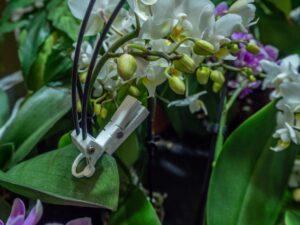
Installation of the Sendot Photosynthesis Sensor in the Greenhouse
The sensor comes with a clip equipped with two optical fibers. We recommend affixing this clip horizontally onto the most recently developed leaf (typically at the top of the crop), where shading from other leaves is minimized. This placement ensures the collection of reliable data and allows for the detection of subtle differences on a weekly basis.
Analysis of Data from the Sendot Photosynthesis Sensor
The data provided by the sensor offers invaluable insights. For instance, a low photosynthetic efficiency may indicate stress due to excessive light, a CO₂ deficiency, or another suboptimal climatic factor. Conversely, a high photosynthetic efficiency suggests that the plant is capable of handling significantly more light than it currently receives. By meticulously analyzing this data, you can prevent overexposure and optimize the plant’s photosynthetic processes, thereby cultivating a more resilient crop that typically yields higher outputs and/or energy savings.
With the Sendot Photosynthesis Efficiency Sensor, you can:
-
- Optimize your lighting strategy: Leverage real-time insights into the plant’s light utilization to fine-tune your lighting approach.
- Reduce plant stress: Implement shading at the precise moments when the plant is unable to efficiently convert light into growth.
- Lower energy costs: Align the lighting more closely with the actual needs of the plants
Read more about the application of photosynthetic efficiency:
Data from the Greenhouse: Photosynthetic Efficiency – Part 1
Data from the Greenhouse: Photosynthetic Efficiency – Part 2
Sigrow Soil Pro+ Sensor
The Sigrow Soil Pro+ sensor captures both soil and climate data simultaneously. Regarding the soil, it measures moisture content (VWC), electrical conductivity (EC), and soil temperature. Additionally, it records key climate parameters such as PAR, ambient temperature, and relative humidity.
Light Measurements:
- Photosynthetically Active Radiation
- Daily Light Integration
Air Measurements:
- Air and dew point temperature
- Relative Humidity
- Absolute Humidity
- Moisture Deficit
- Vapor Pressure Deficit
Soil Measurements:
- Soil Electrical Conductivity (EC)
- Soil Moisture
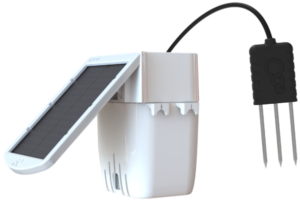
Installation of the Sigrow Soil Pro+ Sensor in the Greenhouse
For accurate soil measurements, it is essential that the probe—equipped with three pins—is inserted into the root zone. For above-ground monitoring, it is advisable to mount the sensor on a stand so that the housing is positioned above the crop canopy. Thanks to the three-meter-long cable, there is ample reach to install the sensor correctly above ground. Additionally, ensure that the solar panel receives sufficient sunlight to recharge the battery effectively.
Analyzing Data from the Sigrow Soil Pro+ Sensor
The data provided by the Soil Pro+ sensor enables users to draw correlations between soil and climate conditions. For example, you can observe how soil moisture and EC interact, which aids in optimizing both irrigation and fertilization. Concurrently, temperature and PAR values offer insights into the interplay between soil and air conditions and their collective impact on plant development.
With the Sigrow Soil Pro+ Sensor, you can:
- Optimize Water Management: Achieve precise irrigation control through accurate soil moisture measurements.
- Enhance Crop Health: Detect stress factors in both soil and climate conditions to improve overall plant vitality.
- Increase Fertilization Efficiency: Gain valuable insights into soil EC levels to fine-tune nutrient application.
Sigrow Air Pro+
The Sigrow Air Pro+ is entirely dedicated to measuring air parameters within the greenhouse. This sensor records PAR, temperature, relative humidity, and CO₂ concentrations, thereby providing a comprehensive overview of the atmospheric conditions that directly affect photosynthesis and overall plant health.
Light Measurements:
- Photosynthetically Active Radiation
- Daily Light Integration
Air Measurements:
- Air and Dew Point Temperature
- Relative Humidity
- Absolute Humidity
- Moisture Deficit
- Vapor Pressure Deficit
- CO₂ Concentration
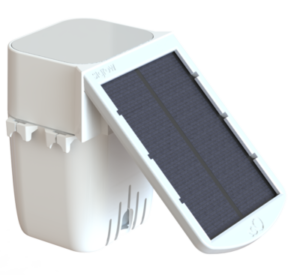
Installation of the Sigrow Air Pro+ Sensor in the Greenhouse
The Air Pro+ should be mounted horizontally and can be placed at any point of interest. Often, it is installed at the crop’s head height—referred to as the microclimate. Alternatively, when a comparison with the greenhouse’s macroclimate is desired, the Air Pro+ is mounted one or two meters above the crop. Additionally, a third sensor can be positioned within the crop canopy to monitor local air conditions and map the absorbed PAR of the plants. Frequently, the Air Pro+ and other Sigrow sensors are mounted using Sigrow’s magnetic sensor holder.
Analyzing Data from the Sigrow Air Pro+ Sensor
The data provided by the Air Pro+ offers a detailed depiction of the greenhouse’s air quality. For instance, high relative humidity may indicate a risk of mold, while excessively low humidity can lead to plant dehydration. CO₂ measurements are essential to determine whether plants have sufficient access to this crucial photosynthetic building block. By integrating these data, you can optimize the greenhouse climate effectively.
With the Sigrow Air Pro+ Sensor, you can:
- Maximize photosynthesis by optimizing CO₂ levels.
- Minimize climate stress by precisely regulating humidity and temperature.
- Save energy by enhancing the efficiency of climate control.
Sigrow SiPixel Sensor
The Sigrow SiPixel Sensor measures various variables: light, air, and plant infrared.
Light Measurements:
- Photosynthetically Active Radiation
- Daily Light Integration
Air Measurements:
- Air Temperature
- Dew Point
- Relative Humidity
- Absolute Humidity
- Moisture Deficit
- Vapor Pressure Deficit
Plant Measurements:
- Leaf Temperature
- Leaf Vapor Pressure Deficit
Installation of the Sigrow SiPixel Sensor in the Greenhouse
The SiPixel is mounted no more than half a meter above the crop. The leaf temperature sensor is directed toward the crop—this can be a leaf, flower, or head. The sensor requires a distance of between 5 and 10 centimeters; the farther it is placed, the larger the area it measures.
Analyzing Data from the Sigrow SiPixel Sensor
The plant-IR data enables you to monitor crop health by assessing leaf temperature. A leaf temperature that is too high may indicate heat stress, while a temperature that is too low suggests suboptimal absorption of light or moisture. By combining this data with measurements of PAR and relative humidity, you can better respond to the plants’ needs and reduce stress.
With the Sigrow SiPixel Sensor, you can:
- Prevent heat stress by continuously monitoring leaf temperature.
- Optimize lighting conditions by analyzing how much PAR is utilized by the crop.
- Improve crop health by precisely regulating the microclimate around the plant.
Quantified Firefly Sensor
The Quantified Firefly is a sensor that offers multiple measurement options and can be integrated with a range of external sensors. It features capabilities for measuring PAR, temperature, barometric pressure, and relative humidity. Moreover, the sensor can be expanded with external devices such as soil moisture (VWC), soil electrical conductivity (EC), soil temperature, plant-IR, and CO₂ sensors.
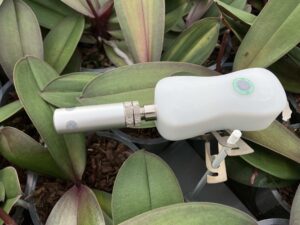
Installation of the Quantified Firefly Sensor
The installation process is as follows: After activating the gateway (the central connection hub via 4G or ethernet cable), the Firefly automatically pairs with the supplied magnet upon resetting. The sensor then transmits its measurement data every 5 minutes to the MyLedgnd platform.
Analyzing Data from the Quantified Firefly Sensor
The data provided by the Firefly enables you to analyze both the climatic and soil conditions in your greenhouse. The combination of climate, CO₂, and soil/substrate measurements helps you understand the interactions between light, air, and soil parameters—for example, how humidity influences the crop’s water uptake.
With the Quantified Firefly Sensor, you can:
- Obtain a comprehensive overview of both the greenhouse climate and the soil/substrate conditions.
- Reduce energy costs by tailoring lighting and ventilation to the crop’s actual needs.
- Collect flexible and specific data, thanks to its modular expansion capabilities.
New articles
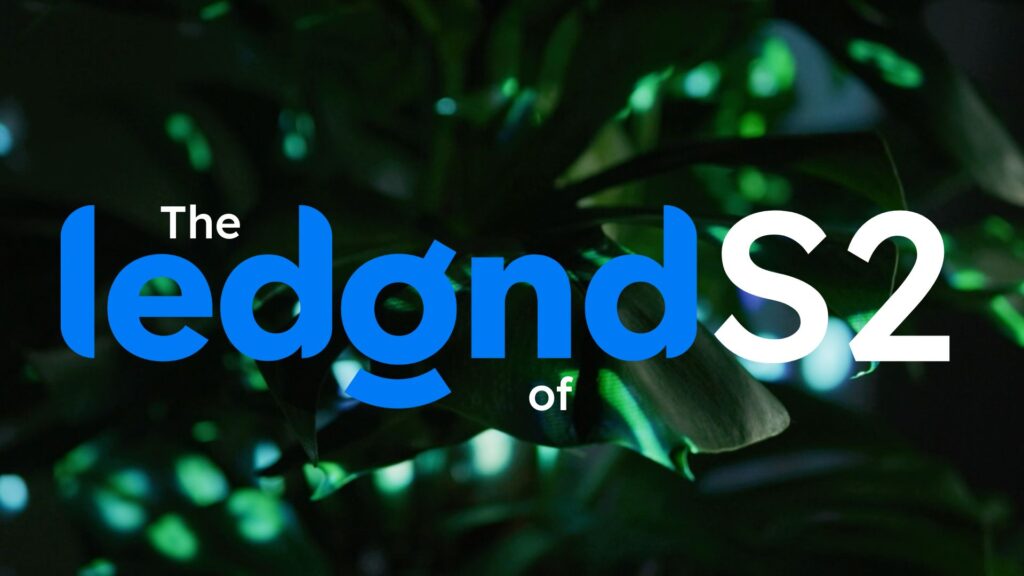
Ledgnd launches season 2 of video series “The Ledgnd of”
Ledgnd has launched the second season of its video series “The Ledgnd of”. The series takes a closer look at the key concepts and innovations shaping modern greenhouse horticulture. In the new season,…

Ledgnd at Hortibiz Next Level Data: From data to action
During the theme week “Next Level Data, Artificial Intelligence and Robotics” by Hortibiz News Radio, Ledgnd joined the table to talk about one key question: how do you turn all greenhouse data back i…

Duijvestijn, Ledgnd and Gavita International continue collaboration on LED optimization
Following the success of the first LED optimization trial at Duijvestijn Tomaten in Pijnacker, Duijvestijn, Ledgnd and Gavita International are launching a second research phase to be conducted over t…
Read more

Ledgnd launches season 2 of video series “The Ledgnd of”
Ledgnd has launched the second season of its video series “The Ledgnd of”. The series takes a closer look at the key concepts and innovations shaping modern greenhouse horticulture. In the new season,…

Ledgnd at Hortibiz Next Level Data: From data to action
During the theme week “Next Level Data, Artificial Intelligence and Robotics” by Hortibiz News Radio, Ledgnd joined the table to talk about one key question: how do you turn all greenhouse data back i…

Duijvestijn, Ledgnd and Gavita International continue collaboration on LED optimization
Following the success of the first LED optimization trial at Duijvestijn Tomaten in Pijnacker, Duijvestijn, Ledgnd and Gavita International are launching a second research phase to be conducted over t…
Do you want to know more?
Interested in what Ledgnd can do for you? Leave your phone number, and we will contact you as soon as possible for a non-binding informational conversation

